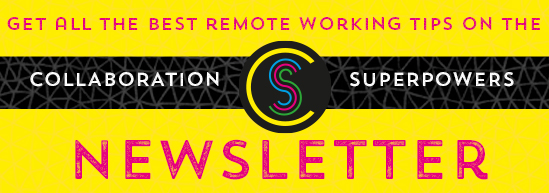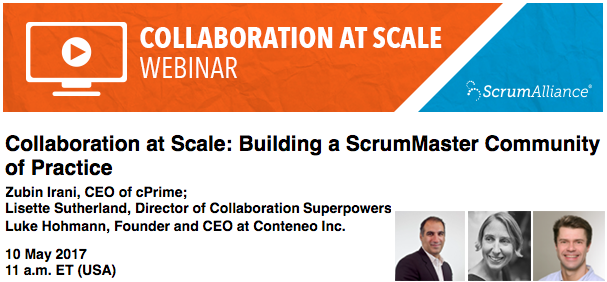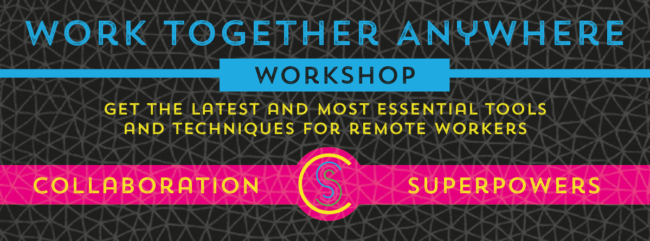A community of practice (CoP) is a group of people who share a craft or profession. They play an integral role in the social fabric of knowledge because they are a way for people to share experiences, learn, and develop competence together as a collective, both personally, and professionally. CoPs aren’t anything new; however, new advancements in technology are now allowing people to form them online.
A CoP can evolve naturally when people have a common interest in a specific area, or it can be created deliberately in order to gain knowledge related to a specific field. Whilst there is a multitude of options for creating a CoP online these days, it’s important not to rely on tools as the only method of communicating. Instead, we have to find ways to reach through the screens and keep our interactions human. The tools are only there to assist us and enhance our ability.
Subscribe to the Collaboration Superpowers Podcast on iTunes or Stitcher.
How to develop virtual communities of practice
- HOST ONLINE VIDEO CALLS. The most common way to form an online CoP is by hosting video calls using conferencing tools like Hangouts, Zoom, or BlueJeans. Keeping conversation casual –getting to know your community first will help to build trust among everyone.
- SET UP VIRTUAL COWORKING SPACES. Virtual coworking is the same thing as working in a physical coworking space, except you meet online… in a virtual office.
- ORGANIZE AN ONLINE CONFERENCE. An online conference is a great way to gather people around a topic. Invite people to give a presentation, host a panel discussion, or run an online workshop. While you don’t exactly get the benefit of networking in person, you get a different kind of interpersonal interaction and a lot of knowledge.
- JOIN VIRTUAL TEAM TALK. Virtual Team Talk is a Slack and virtual coworking group that hosts regular meetups, lean coffees, and conferences using Sococo. Join us! It’s free.
- USE THE “HOT SEAT” TECHNIQUE TO GET YOUR PROBLEM SOLVED FROM DIFFERENT ANGLES. A hot seat is where one person comes to the group with a problem or issue they want to solve. The group will then approach that problem or issue from different angles and help give the person in the hot seat ideas on how to move forward and solve that particular issue.
- SHARE INFORMATION WITH OTHERS ASYNCRONOUSLY. These days, it’s possible to interact with people without video technology. You can use asynchronous tools like Slack, where you can share information, knowledge, and experiments with messages. Plenty of online communities operate effectively online with only written communication.
- CHOOSE THE RIGHT TECHNOLOGY. The platform you use for your CoP will either help or hinder how you connect with and engage your group. Technical hiccups are bound to happen, but you can do your best to avoid them by making sure you have good bandwidth and that you give yourself ample time to set up. Being prepared will make it easier to facilitate and build a community online. If you and your circle are new to virtual meetups, KEEP IT SIMPLE. Good online facilitation is much more important than fancy tools and gadgets.
- USE VIRTUAL ICEBREAKERS. Icebreakers are instrumental in helping people get to know each other. These are quick and fun games or activities intended to relax the participating members and get the conversation flowing. They can be used at the beginning of a CoP meetup as a way of “breaking the ice”.
- HAVE AN AGENDA. It’s important to have a purpose for any meeting and to go over it with all attendees at the beginning. This will establish structure and a guideline of what you will be discussing. It’s also a good time to set expectations so that people can agree on how and when they will communicate before and after the meeting.
- MAKE SURE EVERYONE PARTICIPATES. There are many reasons people don’t talk, from shyness to skepticism. If you’re hosting a CoP meeting, try to encourage people in a gentle tone to add to the conversation. A little reassurance goes a long way.
Podcast production by Podcast Monster
Graphic design by Alfred Boland
More Resources
On 10 May 2017 join Luke Hohmann, Zubin Irani, and myself for a ScrumAlliance sponsored Community of Practice webinar.
Social group sizes, Dunbar’s number and implications for communities of practice by Emily Webber
https://www.collaborationsuperpowers.com/remote/
Original transcript
Welcome to the Collaboration Superpowers podcast. My name is Lisette and I’m interviewing people and companies doing great things remotely. Hello, everyone, and welcome to episode 139. In about a month, I’ll be participating in a webinar with the infamous Luke Hohmann from Conteneo, and we’re going to be talking about communities of practice. So in preparation for the webinar and to get myself a little bit more knowledgeable about the issue, I’ve been looking up communities of practice and how to do them online. So I wanted to dedicate this podcast episode on how to do that. How do we develop virtual communities of practice? It’s always helpful to start out with definitions, so let’s define what a community of practice is. And luckily, it’s very simple and intuitive, actually to do. We’ve been doing it since the history of time. A community of practice is a group of people who share a craft and/or a profession. And I got that from Wikipedia. So again, it’s just a group of people who share a craft or a profession. Now in the case of the webinar that I’m going to be doing with Luke, the subject is going to be Scrum Masters. So we’re talking about Scrum Master community of practices. But I’ve also been a participant in marketing communities of practice. So it’s just a bunch of marketing professionals who get together and exchange knowledge and try to help each other when we’re stuck on problems.
A long time ago, I worked with a group of programmers that were using the Language, Rebel. And because it was such an obscure language, a community of practice formed around the world for all those who are interested in this particular programming language. Now why we establish communities of practice? Basically, it’s just collective learning. It’s getting together and developing competence together. And we can develop competence on our own, of course. But it sure is helpful when there’s a group of people around us who are passionate and engaged about the same topic and want to help each other.
But then, of course, the question that I wanted to answer was how do we do it online. What does that look like? The most common ways of forming communities of practice online is just using regular, online meetup, so basically, videoconferencing tools like Hangouts or Zoom or BlueJeans. We don’t necessarily need to meet on a regular basis in order to form communities of practice. We could do it asynchronously as well. I mean if you think about it, Facebook groups and LinkedIn groups, these are all in essence communities of practice. We can even use particular channels on Slack or HipChat or any group messaging tool, really, where people can just share information, knowledge, and experiments done. I recently did an interview with Andy Willis from workfromanywhere.life back in episode 132. And he does something with his in-person co-working group called hot seats. And I thought this sounded like a lot of fun. Basically, what it is is one person will come to the group with a problem or issue that they want to solve, and the rest of the group will approach that problem or issue from different angles and help give that person in the hot seat ideas on how to move forward or how to solve particular problems.
And then the last way that I’ve seen people do this online is through online conferences. There are tons of examples of people having conferences in different virtual worlds like Second Life, for example. That’s been happening for about 20 years. But I’m seeing more and more online conferences pop up where it’s just basically a person presenting, and you can see their video and their slides. And you can sign up to see a series of talks. So you don’t get the benefit of networking in person, necessarily, when you’re attending one of these online conferences, but you sure get the benefit of the knowledge you gain from attending these conferences online. The Virtual Team Talk group is a group of people who are discussing virtual teams on Slack. It’s free to join, by the way. Just go to virtualteamtalk.com and fill out the little form at the bottom of the page. They host regular meetups and lean coffees and conferences within a virtual office called Sococo. Longtime listeners of the show will know that I’m a huge fan of Sococo.com. And there are so many opportunities for communities of practice to form there.
Judy Reece, who is a clean language expert and somebody that I interviewed way back in episode 33. She has created what she calls a meta forum, which is a regular meeting of people to talk about clean language, and she essentially just uses Zoom for this. So as you can see, there are tons of options for creating communities of practice online. It’s not that hard to do. But what it does take is somebody to spearhead the movement. It can, of course, self-organize, but it’s definitely helpful when there’s somebody there taking care of logistics and motivating others to contribute.
So to recap on how developed communities of practice online, number one, try hosting online meetings using your standard videoconferencing tools like Hangouts, Zoom, or BlueJeans. By the way, if you want more tool suggestions, then please go to the collaborationsuperpowers.com/remote, and you’ll get a great list of tools for all kinds of things.
Number two, try asynchronous tools like Slack or HipChat where you can share information with other people. Number three, try a Hot Seat and get your problem approached from multiple angles.
Number four, try organizing an online conference. Get people together in a virtual world or a virtual office and start developing competence there. Okay, and I just want to leave you with a note, which is as great as the tools are. Forming a community is not about the tools. It’s about reaching through the screens and keeping our interactions human. So tools are there to enhance that ability. But really, it’s all about the human touch.
Okay, I hope that was useful for you. I look forward to hearing what communities of practice you’re a part of and how you’ve been doing it online. So send me a note. You can find all the information at collaborationsuperpowers.com. I’d love to hear about your experiences and of course would love to share it with other people on the podcast. If you want to hear more stories, tips, and tricks and best practices for working remote, then head on over to the Collaboration Superpowers website and get signed up on our newsletter. Every other week, you’ll get all the best tools, tips, and tricks delivered straight to your inbox. It’s as easy as that.
A big thanks to our awesome podcast producer, Nick Jaworski. He’s the reason that this podcast sounds so pro. You can hire him to make you a star at podcastmonster.com. And another big thanks to the dazzling Alfred Boland, the graphic designer for Collaboration Superpowers. You can hire him to make you look cool at the london.nl. All right, everybody. Until next week, let’s go out and form a virtual community of practice and be powerful.





